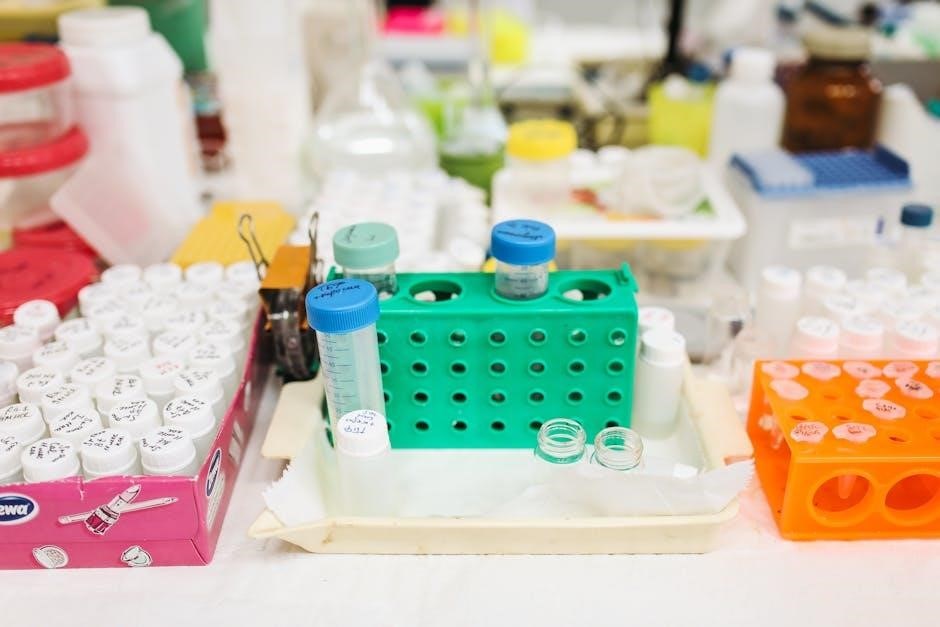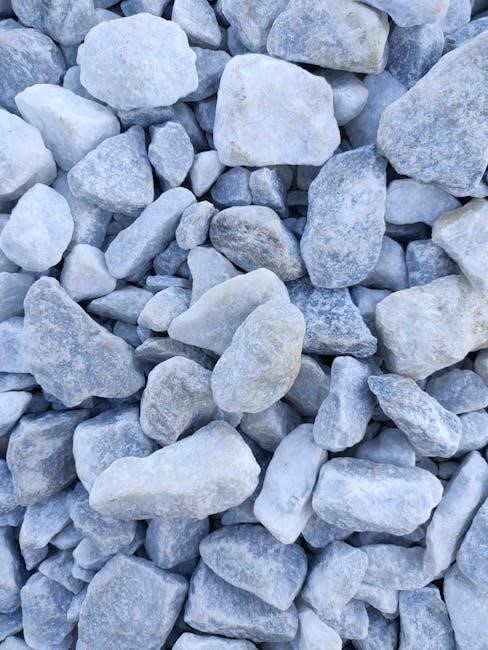Matter is anything with mass that occupies space․ Classifying matter helps organize substances based on composition and properties․ This fundamental concept is crucial for understanding chemistry and the physical world․
1․1 Definition of Matter
Matter is defined as anything that has mass and occupies space․ It is a fundamental concept in science‚ forming the basis of understanding the physical world․ Matter can exist in various forms and compositions‚ ranging from pure substances to mixtures․ Its properties‚ such as physical and chemical characteristics‚ help in identifying and classifying it․ This definition serves as the foundation for further exploration into the classification and properties of matter‚ essential for scientific inquiry and everyday applications․
1․2 Importance of Classifying Matter
Classifying matter is essential for understanding its composition‚ properties‚ and behavior․ It helps identify substances‚ predict their reactions‚ and apply scientific principles․ This process is vital in chemistry‚ enabling the organization of elements and compounds․ Classification also aids in problem-solving‚ experimentation‚ and innovation․ By categorizing matter‚ scientists and researchers can better analyze and utilize materials in various fields‚ from medicine to engineering․ This foundation is crucial for advancing knowledge and practical applications in both academic and real-world settings․
Basic Classification of Matter
Matter is fundamentally classified into two categories: pure substances and mixtures․ Pure substances consist of a single type of matter‚ while mixtures contain multiple substances combined․
2․1 Pure Substances
A pure substance is a material with a consistent composition and properties throughout․ It can be an element or a compound․ Elements are made of only one type of atom‚ while compounds consist of two or more elements chemically bonded together․ Pure substances have definite properties‚ such as boiling points and densities‚ making them distinguishable from mixtures․ Their uniformity simplifies chemical analysis and ensures predictable behavior in reactions․
2․2 Mixtures
A mixture consists of two or more substances physically combined‚ not chemically bonded․ Mixtures can be homogeneous (uniform composition) or heterogeneous (distinct components visible)․ Unlike pure substances‚ mixtures’ compositions can vary‚ and their properties depend on the proportion of each component․ Mixtures allow the components to retain their chemical identities‚ enabling physical separation methods like filtration or distillation․ This classification is essential for understanding diverse material combinations in chemistry and everyday applications․
Types of Pure Substances
Pure substances are materials with a consistent composition․ They can be elements‚ consisting of a single type of atom‚ or compounds‚ made of two or more elements chemically bonded․
3․1 Elements
Elements are pure substances consisting of only one type of atom‚ distinguished by their atomic number․ They are the simplest form of matter and cannot be broken down into other substances by chemical means․ Elements are the building blocks of matter and are represented on the periodic table․ Each element has unique physical and chemical properties‚ making them essential for understanding the composition of all materials in the universe․ They form the foundation of modern chemistry and physics․
3․2 Compounds
Compounds are pure substances formed when two or more different elements combine in a fixed ratio․ They have unique properties and can be broken down into simpler substances through chemical reactions․ Unlike mixtures‚ compounds have a definite composition and can be represented by chemical formulas․ Examples include water (H₂O) and carbon dioxide (CO₂)․ Compounds are essential in chemistry‚ as they exhibit distinct physical and chemical properties‚ making them vital for various applications in science and everyday life․

Types of Mixtures
Mixtures can be classified as homogeneous or heterogeneous․ Homogeneous mixtures have a uniform composition‚ like saltwater‚ while heterogeneous mixtures have distinct components‚ such as sand in water․
4․1 Homogeneous Mixtures
Homogeneous mixtures have a uniform composition throughout‚ meaning their components are evenly distributed․ Examples include air‚ saltwater‚ and alcohol solutions․ In such mixtures‚ the particles are molecularly dispersed‚ making it impossible to distinguish the individual substances visually․ This type of mixture is consistent in both physical properties and chemical composition․ Homogeneous mixtures can be separated into their constituent parts through physical methods like distillation or evaporation․ Understanding them is essential in chemistry for solutions and solvent studies․
4․2 Heterogeneous Mixtures

Heterogeneous mixtures consist of components that are not uniformly distributed‚ meaning their composition varies throughout․ Unlike homogeneous mixtures‚ heterogeneous mixtures have distinguishable phases or particles․ Examples include sand in water‚ oil droplets in vinegar‚ or trail mix․ These mixtures are easily separable through physical methods like filtration or sedimentation․ They are common in everyday applications‚ such as culinary practices and industrial processes‚ where understanding their composition is crucial for specific uses․ This classification is vital for studying mixtures in chemistry and real-world scenarios․

Properties of Matter
Properties of matter describe its characteristics‚ such as color‚ odor‚ and density (physical) or flammability and reactivity (chemical)‚ which help identify and classify substances effectively․
5․1 Physical Properties
Physical properties are characteristics of matter that can be measured without altering its identity․ Examples include color‚ odor‚ taste‚ shape‚ melting point‚ boiling point‚ solubility‚ magnetism‚ and density․ These properties provide essential information about a substance’s behavior under various conditions․ For instance‚ measuring conductivity or density helps distinguish between different materials․ Physical properties are fundamental in classifying and identifying substances‚ as they remain consistent regardless of the sample size or form․
5․2 Chemical Properties
Chemical properties describe a substance’s ability to undergo specific chemical changes․ Examples include flammability‚ reactivity with acids or bases‚ oxidizing properties‚ and the release of gases upon decomposition․ These properties are evident only when a chemical reaction occurs‚ altering the substance’s composition․ Unlike physical properties‚ chemical properties cannot be observed without a reaction․ They are crucial in understanding how substances interact and transform‚ making them vital for identifying and classifying matter in chemical processes and reactions․
States of Matter
Matter exists in three primary states: solid‚ liquid‚ and gas․ Each state has distinct physical properties‚ such as shape‚ volume‚ and particle arrangement‚ defining its form under specific conditions․
6․1 Solid
A solid is a state of matter with a fixed shape and volume․ Its particles are tightly packed in a regular structure‚ resisting compression and maintaining their arrangement․ Solids exhibit rigidity‚ meaning they do not flow like liquids or gases․ Examples include metals‚ minerals‚ and wood․ Solids can be pure substances‚ like elements or compounds‚ or mixtures․ Their physical properties‚ such as density and melting points‚ are consistent․ Solids play a crucial role in everyday life‚ from construction materials to electronic devices‚ due to their stability and structural integrity․
6․2 Liquid
A liquid is a state of matter with a definite volume but no fixed shape․ Its particles are close together but free to move‚ allowing liquids to flow․ Liquids conform to the shape of their container while maintaining their volume․ Examples include water‚ oils‚ and juices․ Liquids are essential in various applications‚ from hygiene to industrial processes․ Their properties‚ such as viscosity and surface tension‚ vary widely․ Liquids are versatile and vital in both natural systems and human-made technologies‚ playing a key role in sustaining life and enabling processes․
6․3 Gas
A gas is a state of matter characterized by particles that are widely spaced and free to move in any direction․ Unlike solids and liquids‚ gases have neither definite shape nor definite volume‚ expanding to fill their containers․ Properties of gases include compressibility‚ low density‚ and high diffusion rates․ Examples of gases include oxygen‚ nitrogen‚ and helium․ The behavior of gases is governed by laws such as Boyle’s and Charles’s laws‚ which describe how pressure‚ volume‚ and temperature interact․ Gases are essential in various natural and industrial processes‚ from respiration to combustion․

Applications of Matter Classification
Matter classification is crucial in chemistry‚ industry‚ and daily life․ It aids in identifying substances‚ ensuring quality control‚ and solving practical problems efficiently in various fields․

7․1 In Chemistry
In chemistry‚ classifying matter is essential for identifying elements and compounds․ It helps scientists develop accurate formulas and conduct experiments‚ ensuring the purity of substances․ This classification also aids in predicting chemical reactions and understanding molecular structures‚ which is vital for synthesizing new materials and pharmaceuticals․ By organizing substances based on their composition‚ chemists can systematically study their properties and behaviors‚ leading to advancements in various scientific fields and practical applications․
7․2 In Everyday Life
Understanding matter classification impacts daily life‚ from cooking to cleaning․ Recognizing pure substances and mixtures helps in preparing recipes and using household products effectively․ For example‚ knowing the difference between homogeneous and heterogeneous mixtures aids in selecting the right ingredients․ This knowledge also enhances problem-solving‚ like troubleshooting issues with water purity or improving gardening techniques․ By applying matter classification principles‚ individuals can make informed decisions‚ improving efficiency and safety in various routine activities and tasks․
Classifying matter provides a fundamental understanding of its properties and composition‚ essential for scientific inquiry and practical applications․ This knowledge aids in organizing and analyzing the material world effectively․
8․1 Summary of Key Concepts
Matter is classified based on composition and properties․ Pure substances consist of single elements or compounds‚ while mixtures are combinations of substances․ Homogeneous mixtures have uniform composition‚ whereas heterogeneous mixtures do not․ Matter exhibits physical and chemical properties‚ such as color‚ density‚ and flammability․ It exists in three primary states: solid‚ liquid‚ and gas․ Understanding these classifications and properties is essential for analyzing and applying scientific principles in chemistry and everyday scenarios‚ fostering a deeper appreciation of the material world․
8․2 Importance of Understanding Matter Classification
Understanding matter classification is crucial for practical applications in chemistry‚ engineering‚ and everyday life․ It enhances analytical and problem-solving skills‚ enabling better identification and utilization of substances․ Accurate classification aids in predicting properties and behaviors‚ essential for scientific advancements and innovations․ This knowledge also supports environmental sustainability by understanding material interactions and optimizing resource use․ Ultimately‚ grasping matter classification fosters a deeper understanding of the world‚ aiding in informed decision-making and promoting scientific literacy․


